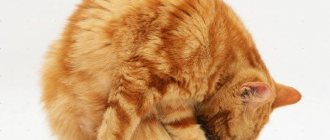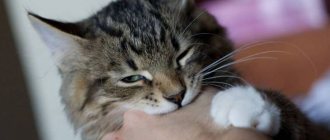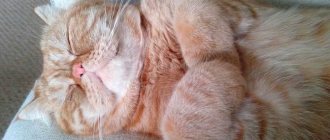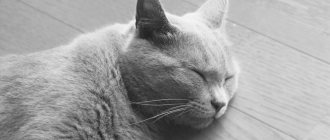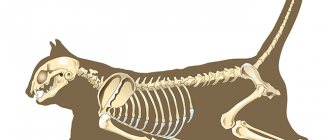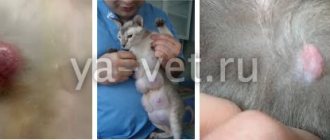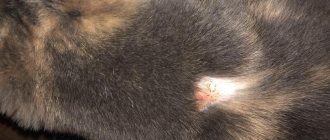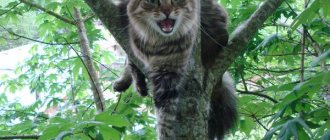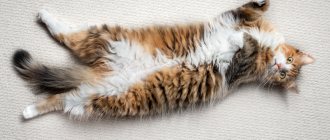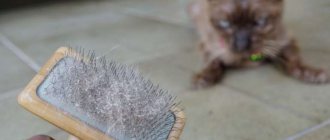Feline hyperesthesia syndrome, which causes discomfort in cats, causes increased skin sensitivity.
Feline hyperesthesia syndrome is also often called twitching skin syndrome, twitching cat syndrome, rolling skin syndrome , atypical neurodermatitis, psychomotor epilepsy and neuritis. No matter what you call it, it's a condition that causes your kitty to experience increased skin sensitivity, so you can imagine how uncomfortable it can be.
Read the information below to learn more about feline hyperesthesia and what you can do if your cat has been diagnosed.
Messages
Pages 1
To post a reply you must log in or register.
Vetlek » Consultation with a veterinarian » Frequent back spasms in a cat
Powered by PunBB , powered by Informer Technologies, Inc.
This is interesting: What to do if the cat doesn’t go to the toilet at all?
Treatment: basic measures
Therapy for convulsive states is necessary in any case, but it is prescribed only after examining the animal. Therefore, all treatment is divided into stages.
Step one - diagnosis
The doctor asks the owner how the attacks manifested themselves and what they were accompanied by. When compiling an anamnesis, it is important to know what the cat ate the day before, how it behaved, and whether there were stressful situations or injuries.
Blood and urine tests are taken from the animal. The cat is sent for hardware examination (ultrasound, MRI). Only after collecting all the results does the doctor move on to the next stage.
Step two - choosing treatment tactics
In each specific case, an individual course of therapy is selected. First of all, it is necessary to act on the factor that provoked the cat’s seizures. Often an epileptic attack is stopped with Promidon.
Symptomatic treatment includes the following:
- prescription of analgesics;
- antiemetics;
- solutions that prevent dehydration;
- vitamin complex.
You can quickly eliminate cramps with Pagliferal or Phenobarbital.
But these injections are done only in a clinic under the supervision of a doctor, since the drugs are toxic and an overdose cannot be allowed.
Causes
It is important to determine the reason why the animal twitches its back and tail. To do this, you should carefully observe the cat. The reasons can be both harmless and dangerous.
Safe Reasons
Cats have vibrissae, which are sensitive hairs in their fur, such as whiskers. On the back they are stiffer than the rest of the hair and may be white. They are designed for orientation in space. If you touch them, the animal will twitch the hair on its back. If you run it against the grain and ruin her hair or ruffle it, she will also twitch and then begin to lick herself, putting herself in order.
If your cat jerks its back or tail, it will be under stress. When she is scared, excited, nervous, she shows her condition by twitching . This phenomenon can often be observed during the mating season. Especially when the animal does not have the opportunity to walk and look for a partner for procreation. You can also observe twitching when she wants to go to the toilet. She may start running, meowing, and freaking out. Thus, by twitching the skin, the animal establishes peristalsis. This is normal behavior for her and should not cause alarm to her owners.
Dangerous reasons
Twitching of the skin on the back can be a sign that your cat's health is deteriorating. In such a situation, the main thing is not to delay and contact a specialist. The veterinarian will order tests, make a diagnosis and prescribe treatment.
A pet may jerk its back due to diseases such as:
- Rabies;
- Hyperesthesia syndrome;
- Cancerous tumors;
- Fleas.
If a cat roams freely on the street, it runs the risk of encountering another animal with rabies. The disease is transmitted through a bite. If you notice that your cat's back is twitching, he has attacks of aggression, is irritable, eats food but does not drink water, immediately take him to the doctor. These are symptoms of rabies.
If the disease is neglected, it will become dangerous for all family members. An animal infected with rabies can infect humans. If the symptom is confirmed by the veterinarian after tests, the cat will be euthanized. Unfortunately, veterinarians have not yet found effective treatment methods that can restore health to a pet.
the cat runs around, licks its paws, tail, and tugs its skin
Get rid of fleas immediately. You have typical symptoms of infection.
Hello! I have the same problem with my cat as you. Unfortunately, I live in Dubai and one visit to the vet costs me $100. And this is without tests and medications. I have already gone to the doctor with my cat twice. Nothing was found. No fleas, no worms. Nothing. They just said that he might have asthma attacks. but again, it’s not clear why he licks the tail, the bottom of the back and the hind legs. and also hides from everyone during attacks. when he runs hard = he breathes like a dog with his mouth open. I really feel sorry for him, but most of all I’m afraid that 2 other cats may become infected. Were they able to help you? please share your experience
Sincerely, Angelika
I found the answer on another forum. This is paraproctitis. Here in Dubai, veterinarians don’t know anything at all. so you need to go to them with a diagnosis and preferably with knowledge of how to treat it, so that they just give the medicine. Ehh, at least it would be confirmed that this is really what we think> Read what I found from other cats. The picture is very similar. “yes, we had this happen, at about one year of age, he sits, twitches his fur and tail nervously, and then when he runs, we asked the vet what this could be connected with. he told us that most likely this is due to the drying out of the anal glands, which secrete secretion to facilitate bowel movements (and not only), if not enough secretion is secreted, then they itchy there, that’s why they get sore, that’s what it looks like. here is a dog in the picture, but cats have the same thing, we didn’t do anything, somehow it went away on its own “
Why does the cat shake its tail?
The tail of cats serves primarily as an indicator of mood. By moving it, they express:
- Anxiety. By wagging its tail and pressing its ears to its head, the pet shows that something is bothering it.
- Willingness to engage in combat with a possible enemy or pursue a victim.
- Doubt.
- Pleasure. Cats wag the tip of their tail when they are happy and try to show their owners the depth of their overwhelming feelings.
- Curiosity. When a pet explores something with interest, its tail twitches.
- Irritation. If an animal actively swings its tail from side to side, it means it is irritated.
Common signs of stress in dogs
- Frequent yawning by your pet when you are sure that he has had enough sleep.
- Hair loss (a common symptom with cats).
- Loss of appetite/overeating (common with cats).
- Chewing/licking front paws.
- “Whale eye” (a common feature with cats).
- Licking lips and nose (common with cats).
- Unreasonable barking or whining.
- Shaking or pinching the tail between the paws.
- Chaotic movements back and forth.
The cat's back twitches closer to the tail. Why does a cat's back twitch?
Domesticated representatives of the cat family are distinguished by their complacent disposition, so they are loved by all family members, regardless of age. If your cat's back is twitching and she begins to behave in an atypical manner, you should contact your veterinarian for a series of tests.
When a cat's back twitches, it is very important to determine the cause of the problem. It is especially necessary to carefully monitor animals that have the opportunity to roam freely on the street. For example, if a cat’s tail and back are twitching, she is periodically very irritable and even aggressive, eats food but refuses to drink, it is necessary to urgently take her to the veterinarian. The thing is that such symptomatic manifestations are often observed with rabies. A cat that often walks outdoors may well become a victim of another animal that has all the signs of this dangerous disease and is capable of transmitting the virus through a bite.
How to tell if an animal is uncomfortable
If you notice that a normally friendly cat or dog has become aggressive or appears scared, does not come out to greet you, or does not respond, these are signs that your pet may be experiencing stress or anxiety. Very often, owners do not pay attention to this, which later results in serious illnesses and troubles.
Veterinarians have been observing pets for a long time in order to determine the sources of anxiety in cats and dogs, as well as to teach owners to recognize signs of stress in their pets.
Why does the animal run and nervously lick itself?
Licking is normal for cats. These clean animals are so sensitive to the cleanliness of their fur that they lick themselves at every opportunity: after eating, going to the toilet, or being touched by their owners. Moreover, by licking their fur coat, they calm down. Licking can be talked about as a normal phenomenon only when it is not fanatical in nature. Why does a kitten or adult cat run around the house and lick nervously?
The cat is stressed
These animals have a very vulnerable psyche. It doesn’t take much for a pet to lose its peace of mind. This can happen due to a trip in a car, a visit to the veterinarian, quarrels in the family, the appearance of a new four-legged inhabitant in the house, moving to another room, changing place of residence, etc. All cats experience stress differently. Some begin to run aimlessly around the apartment and fanatically lick the fur. Sometimes they do this so violently that in some areas of their bodies they become completely bald.
As soon as the factor that provoked the cat’s emotional shock disappears or he gets used to new circumstances, the pet will stop being nervous. However, cats are not always able to overcome stress on their own. Sometimes they need sedatives.
Hyperesthesia syndrome
This rather rare disorder, affecting the skin, neuromuscular and nervous systems, is most often detected in kittens. The reasons for its appearance are unknown, but it is believed to be due to disruption of neurotransmitters in the brain during anxiety.
Animals with this syndrome feel tense all the time and experience increased sensitivity to touch. Their spine and tail are the most vulnerable. They lick the fur too diligently, paying special attention to the most vulnerable areas of the body, sometimes leading to the appearance of bloody wounds. Hyperesthesia syndrome can also be recognized by other symptoms:
- nervous tail beating;
- twitching of parts of the body in the back;
- sudden bursts of activity, sometimes developing into aggression;
- dilated pupils;
- tail biting;
- loud meow.
The cat has fleas, worms or other parasites
The reason for this behavior may be ecto- and endoparasites. They cause the pet a lot of suffering. Especially unbearable for them is the endless itching in places affected by external parasites, such as fleas. It prevents the tailed poor fellows from sleeping peacefully, eating, and spending time carefree. In order to somehow drown it out, they begin to rush around the house and actively lick the irritated skin, often only aggravating the situation.
Having noticed symptoms of a helminthic infestation in a cat, it is necessary to take measures to destroy the pests as quickly as possible. Antiparasitic drugs, especially if they are planned to be used to treat a kitten, should be discussed with your veterinarian.
This is interesting: Instructions for use of the drug Nobivak Rabies for cats
First aid: owner actions
In such situations, a person’s self-control plays an important role. Timely measures taken will help save the life of a pet:
- During an attack, the cat must be carefully laid on a flat surface, which is covered with oilcloth or rags. At the same time, you cannot forcibly hold it, so as not to provoke unnecessary stress. You should not unclench your jaws, so as not to injure the animal.
During an attack, it is recommended to administer an anticonvulsant and analgesic to your pet. They do this by injection, and not by mouth: convulsions that seize the muscles of the larynx will not allow the cat to swallow the medicine, and it will simply choke.- A light massage will help ease the spasm. It is carried out on areas of the body affected by convulsions.
Even a small isolated attack is already a reason to urgently take your pet for examination. Convulsive muscle contractions don’t just happen. There needs to be a reason for this, and each of them is dangerous.
Types and signs of seizures
There are several signs by which seizures are usually classified:
- non-epileptic and epileptic seizures can be based on the mechanism of development;
- according to prevalence, they distinguish between limited or local/focal, generalized and unilateral;
- Based on the time during which a group of muscle fibers contracts, they are divided into: myoclonic, tonic and clonic convulsions.
Epileptic convulsions occur under the influence of hypersynchronous discharge. As is known, the brain, or more precisely, neurons communicate through weak electrical discharges; the simultaneous discharge of a large group of neurons leads to characteristic attacks of uncontrolled muscle contractions.
Non-epileptic seizures can have a wide variety of causes, from vitamin B6 deficiency, toxin poisoning, convulsive form of fainting to endocrine disorders or organic damage to brain structures.
Myolonic seizures are short-term seizures.
Clonic - represent a frequent change in the tone of muscle fibers or their groups, in other words, twitching.
Tonic is a fairly prolonged muscle spasm.
The animal, neither during the attack nor after it, can in any way describe its condition, so the owner needs to be very attentive to his pet, and if he notices the following signs, be sure to take the cat for a consultation to the clinic, even if after the attack the animal looks healthy:
- convulsions of the whole body or convulsive twitching of the paws;
- tense, crooked legs tucked under the stomach;
- loud painful cry of an animal with cramped limbs;
- the animal falls to the floor in convulsions or moves its paws back, as if trying to stretch;
- the animal's pupils are dilated, its whiskers are pressed down;
- if the convulsions are focal, the animal is conscious, it is not given to the owner;
- involuntary urination (in severe cases);
- foaming from the mouth (also in severe cases).
With mild cramps of the limbs, sometimes the animal tries to rise, but to no avail. But more often, until the end of the attack, the cat is afraid to move, because movements can cause pain. But pain is not necessary. Sometimes convulsive attacks are not accompanied by severe discomfort, so the animal can behave calmly, despite the twitching limbs.
After the seizure ends, the animal can behave as usual, as if nothing had happened. Or he may lose orientation for a while and not find his favorite place or bowl.
Metabolic disorders
Failures in the functioning of internal systems disrupt metabolism and the rhythm of metabolic processes. This leads to an imbalance in the nervous system, and impulses are sent to the muscles “incorrectly,” which manifests itself in convulsions.
Metabolism-related diseases
| Name | Peculiarities |
| Eclampsia | It is observed during the period of gestation of kittens, at birth and feeding. A convulsive state develops against the background of a sharp decrease in the level of calcium in the blood and is accompanied by severe pain. In the initial stage, convulsive twitching is observed in the hind limbs. As the attacks progress, they become more frequent and affect the entire body. |
| Kidney failure | There are many factors that provoke this disease, from common infections to autoimmune pathologies. Failure of the kidneys interferes with the removal of toxins from the body. As a result, brain tissue is damaged. |
| Hypoglycemia | Blood glucose levels drop sharply. Convulsive attacks are accompanied by severe pain, causing the animal to writhe and scream loudly. This condition is similar to epileptic seizures |
| Intoxication | Toxic substances that enter a cat’s body have a negative effect on the nervous system. In mild cases, this provokes stool upset. In severe situations, intestinal bleeding is added to diarrhea. The cat is vomiting and writhing in convulsions |
Any disruption of metabolic processes if assistance is not provided in a timely manner will lead to the death of the pet.
Old age can also be included in this group of pathologies. In the body of old cats, degenerative processes occur that affect almost all organs, but the brain is the first to suffer.
Involuntary muscle twitching may be pre-death convulsions.
When to contact a veterinarian
If the owner, after analyzing his pet’s trembling on his own, does not find an explanation for it, he will have to immediately contact a specialist at the nearest veterinary clinic. As the animal begins to tremble, its behavior may change; overnight, a beloved cat may become aggressive. In addition to the reasons described above that cause tremors in a cat in a lying position, there are many other less harmless reasons that cause tremors.
These include:
- The cat has helminths.
- Lack of vitamins in the cat's body (especially calcium and vitamin B).
- Diseases of internal organs (in particular the kidneys - the presence of urolithiasis in the animal).
The veterinarian will send the animal along with the owner to undergo all the necessary tests and an ultrasound of the internal organs, and then give recommendations on the necessary treatment.
- Published in
- Health
Where to go to find out the causes of stress?
If you notice these signs, then you should take your friend to the veterinarian first. Anything can be done only after consulting a doctor to rule out any problems with the pet’s health. If tests and examinations indicate that your friend is physically healthy, then it’s worth figuring out what exactly brought him to this state.
It's easy to update an old countertop with concrete: a simple master class
The strawberry harvest will increase many times: we water the bushes in the spring with garlic fertilizer
Menshikov and his young beautiful wife: why the couple has no children
Characteristic symptoms
Depending on the type of disease, various signs are present. Characteristic symptoms may be observed:
- pus in the ear canals;
- active scratching of ears with paws;
- tremor;
- lethargy of the animal;
- refusal to eat;
- unsteady gait;
- general malaise.
To make a correct diagnosis and prescribe effective treatment, it is recommended to promptly examine your pet by professional veterinarians. Proper treatment will avoid severe complications and death.
With brain damage
Pathologies affecting this organ are the most dangerous. Defeat can be caused by both external factors and internal processes.
Causes
| Disease | Peculiarities |
| Tick-borne encephalitis | When an ixoid tick bites, an infection enters the cat's body with the insect's saliva, causing the disease. Characteristic signs other than seizures:
|
| Hypoxia | Oxygen starvation can occur for a number of reasons, but in any case it leads to damage to brain tissue. At first, the symptoms are mild, and the seizures are so short-lived that the owner may simply not notice them. As the pathology develops, the number of convulsions and their duration increase. Hypoxia can be suspected by suddenly appearing shortness of breath, fainting, or cyanosis of the mucous membranes. |
| Rabies | Not just dangerous - a fatal disease caused by Babes Negri bodies. The animal's hind legs twitch first, then its limbs become paralyzed. While the cat is able to move, it shows strong aggression. The disease develops rapidly. Spasms pass from the body muscles to the respiratory muscles, and the animal dies from suffocation |
| Tumors | The initial stage of oncology has no obvious symptoms. They will appear when the tumor, growing, begins to put pressure on important areas of the brain. The animal's behavior changes: the cat becomes aggressive, loses orientation - constantly bumps into walls, objects, and monotonously circles in one place. The disease is often accompanied by convulsive seizures |
| Hydrocephalus | The cause is disruption of the outflow of fluid from the brain. The pathology is congenital and can be detected at an early stage. A kitten suffering from hydrocephalus has a larger skull volume than healthy babies, and it lags behind its brothers in development. The disease manifests itself as clonic convulsions, the first signs of which can be noticed at 2 months of age. The rapid development of pathology leads to death |
| Hematomas, injuries | Damage to the skull is accompanied by profuse vomiting. With severe injuries, loss of consciousness, paralysis of a group of muscles and twitching of those that hold the eyeballs are possible. |
Even an unbalanced diet, which provokes the development of vitamin deficiency, can cause brain damage.
In particular, this concerns vitamin B1 (thiamine), which is necessary for the smooth functioning of systems. The initial stage is manifested by trembling of the limbs; with severe deficiency, convulsions are observed.
The tail is an indicator of the cat's emotions
Most often, a cat twitches its tail to communicate its mood. Depending on how and how actively she begins to move it, the owner can guess what emotions his pet is experiencing:
- Excess of feelings. Often a cat's tail twitches when a person pets the animal. Combined with purring, this means that the cat is absolutely happy. He is satisfied with the owner's attention and hurries to tell him about it.
- Interest in something. The cat's tail stands upright when the pet is happy and expects something pleasant (for example, it is time to feed). But when he begins to smoothly move it up and down, this is a sign that the cat is interested in some thing or object. He will walk around it, sniff it, try to catch it. It could be anything: a fly flying by, a new toy, a bag of groceries.
- Irritation. Experiencing such emotions, the cat begins to rhythmically jerk its tail left and right. This is how she shows that the current situation is unpleasant for her. For example, a pet may feel that the timing for affection is poorly chosen.
- Fear, panic. It is not difficult for a person to determine that a cat is very scared - the animal twitches its tail, hitting it on the floor with all its force. His whole body is shaking, his pupils are dilated, and the cat itself can make plaintive sounds. At such moments, the pet should not be touched. The best thing the owner can do is to eliminate the situation or object that frightened the animal.
A small kitten often jerks its tail upward when it wants to play, run, or catch mice. Twitching is accompanied by the baby jumping on the owner's legs and various objects in the house. This is the most active age of a cat, and she encourages the owner not to forget about her needs.
Scared
If your cat tends to wrap her tail around your legs while you're exploring another room or walking, it could mean she's scared. In this case, wrapping is the same as holding hands. Your cat is nervous and wants to cuddle you while you investigate the situation. They don't want you to pick them up because they might need to get away quickly, but they want to come with you, so they wrap their tail around you for safety. Of course, you can go into another room to get a pencil or answer a phone call, so this behavior will seem strange to you.
Twitching of the cat's tail and back
Sometimes cats not only twitch their tail, but also their back. There are several reasons that cause this animal behavior. A cat constantly jerks its tail and rear part of its body in the following cases:
- during puberty she has a sexual desire, but there is no way to satisfy it;
- the animal has fleas;
- the pet has been struck by cancer - a tumor has arisen in the spinal cord or brain.
In addition, the cat may twitch its back and tail due to neurosis. In veterinary medicine it is called hyperesthesia syndrome. Suffering from this disease, the animal begins to lick its paws, back, and anus for hours. His fur becomes wet from saliva and does not have time to dry before the next wash. Such actions of the pet indicate nervous exhaustion, lack of attention from the owner, and severe stress.
Excessive licking of the body provokes dermatitis of the animal. Due to constant itching, the cat will begin to twitch its back and tail, wanting to get rid of the unpleasant sensations. If the cat owner ignores this problem, then patches will form in the licking areas, and a fungal disease may develop in the future.
Mechanism of seizures
Convulsive twitching of the paws or the whole body is always frightening.
Especially if you don’t know the nature of this phenomenon. This behavior is not typical for animals. Seizures are a dangerous pathology that is not an independent disease. Muscle spasms are a sign that some organ or system of the animal has malfunctioned and affected the functioning of the brain.
How does this happen
By nature, cats have tissues and ligaments of the muscular system that are quite elastic. That’s why they manage to change so quickly from a relaxed state to an active one and vice versa. This transition is so smooth that it is difficult to notice from the outside.
But convulsions immediately catch the eye. At the same time, the cat not only twitches the body or individual areas - muscle cramps are accompanied by painful spasms.
Twitching can be single or repeated at regular intervals. But spasms always come suddenly and manifest themselves in different ways.
Types of seizures in cats
| Type | How it manifests itself |
| Convulsive | Mild twitching or muscle contractions are observed. The pet responds adequately to the owner |
| Tonic | Short-term, but repeated slow muscle contractions with a certain periodicity. The cat behaves restlessly, not just meows, but howls |
| Clonic | Contractions alternate with relaxation. The cyclicity is about 30-120 seconds. During convulsions, the pet falls on its side, and in the intervals between them makes attempts to move |
| Epileptic | The cat's muscles are constantly tense, he himself is in an unconscious state, often with his eyes open. If relaxation occurs, it lasts a few seconds. |
The last type of seizure is the most dangerous, as it usually ends in the death of the animal.
But even convulsive twitches do not go unnoticed for your pet.
Therefore, it is important, with the help of a specialist, to determine the cause that provoked the seizures and try to eliminate it.
Caution - rabies
If the cat is free-range, its behavior must be observed especially carefully. On the street there is a high risk of contracting various infectious diseases, many of which are fatal.
Having noticed a twitching of the tail and back of a freedom-loving cat, the owner needs to sound the alarm and find out why this is happening. These symptoms are often used to identify rabies. This disease is dangerous for both the pet and its owner. It threatens irreversible damage to the spinal cord and brain. In addition to the fact that the animal begins to twitch its tail and back, there are other signs of rabies:
- the cat eats food but refuses to drink water;
- the animal becomes aggressive or, conversely, tries to hide from people;
- have difficulty swallowing food;
- saliva is produced profusely;
- the pet begins to constantly bite itself at the place through which the infection entered the cat’s body.
But whatever the symptoms, only a veterinarian can accurately answer the question of why the cat is twitching its tail. However, if rabies is confirmed, the animal will have to be euthanized.
There are a number of reasons why a cat shakes its tail, the most mobile part of its body. As an extension of the spine, the tail is equipped with a dense network of nerve fibers. Thanks to this, various movements are considered by a person as a kind of “language” of the pet and allow the owner to understand his cat. Unlike dogs, cats convey many emotions with their tail.
She loves You
Cats have a strange way of showing affection compared to many other animals, especially dogs. They can usually only tolerate petting for a short time and generally do not like to be cuddled. If they like you, they will sit next to you and follow you around the house, but will remain out of reach.
A cat sitting at your feet and gently hitting you with its tail is most likely showing you a sign of affection, which is not so different from affection. If your cat tries to imitate your affectionate behavior, it could be a sign of deep love.
Seizures caused by metabolic disorders
Pathologies of organs and endocrine glands in cats can also cause seizures. This is due to a violation of the metabolism of individual elements, inflammation and intoxication phenomena caused by untimely removal of decay products from the body.
Eclampsia
A decrease in the concentration of calcium in the blood serum to a critical level in pregnant and lactating cats is manifested by changes in behavioral reactions and frequent painful convulsions. First, the hind legs and facial muscles twitch. Gradually, other parts of the body are involved in the process, attacks become more frequent and intensified.
The cat falls over on its side, makes uncoordinated movements, and the state of apathy is replaced by sudden excitement. Severe forms end in coma and death.
Hypoglycemia
A sharp drop in blood sugar can cause clonic-tonic seizures, similar to epileptic seizures. This usually occurs after a large dose of insulin is injected for diabetes.
In this case, the glucose level should be immediately stabilized by oral administration of a sweet solution.
Kidney failure
The reasons for the development of this complex of symptoms may be autoimmune diseases, inflammation, infectious lesions, and poisoning. An attack can develop after anesthesia administered without observing the dosage.
Due to impaired elimination of toxins during renal failure in cats, symptoms of central nervous system damage rapidly increase, expressed in convulsions and paralysis. And when the disease passes the terminal stage, destructive processes begin in the brain, leading to the death of the animal.
Old age
Seizures in an old cat may be a consequence of a chronic form of pathology. It can form as a result of improper feeding, infections, poisoning or urolithiasis that developed after sterilization. The degeneration of kidney tissue in chronic renal failure is considered irreversible, therefore modern veterinary medicine does not have methods for treating the disease.
Rules for taking anticonvulsants in veterinary medicine
When a veterinarian prescribes anticonvulsants, you must adhere to the established rules:
- The dose and schedule for taking the medicine must be strictly established; chaotic use is not allowed.
- You should not spontaneously stop treating your cat - this can lead to stronger seizures.
- If the drug runs out, you need to worry about buying a new package in advance. If the medicine is given on a prescription, you must notify your veterinarian.
- The product must be stored in a safe place, out of reach of animals or children.
- You need to consult a veterinarian about compatibility with other drugs, if there is a need for supplements.

